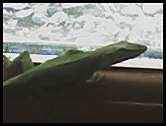Meet Elvis...


Well, not much happening this Friday. I spent way too much time playing video games on liquid generation and now I remember why I stopped playing them years ago. High blood pressure runs in my family. Anyway, the store officially has a pet now. He's been lingering around since early August and eating a few bugs but sadly I think Elvis is about to die. He was a really bright green color and now he's starting to turn brown. Maybe lizards don't have that long of a life span. I did get to snap a couple of pictures of him with my camera phone. The ass clown that told us this took high quality pictures should be beaten over the head with it until he passes out. The last guy at Verizon said he would e-mail all the pictures to himself as soon as he took them in case he lost them. Somehow I think any pictures I take with my camera phone are expendable. I meant to bring my digital camera today but I forgot it, maybe Elvis will be around Monday and I can get some better pictures of him. Have a good Friday everyone. Elvis says have a good weekend.









4 Comments:
This is what I found:
----------------------------
Garden Dragon aka Green anoles (Anolis carolinensis)
Their ability to change color between green and brown has given the anoles their common name of "chameleon;" however, they are more closely related to iguanas than the prehensile-tailed, long-tongued slow lizards of Africa. The color changes are caused by hormones and can be triggered by temperature, background color or mood. Cooler temperatures cause the lizards to usually be brown, and there are two types of brown, with the darkest being when they are really cold. A lighter brown color is evident when the anoles are on the bark of a tree or other dark background. The lizards are green when they are very warm, or in green vegetation. Newborn anoles always seem to be a gray color instead of green or brown, but they soon acquire the ability to change to the other hues just like the adults. The female lizard (with a belly distended by eggs) pictured to the right is mostly brown but has a bright green patch, which sometimes happens when the lizard has been leaning against something or been only partly in the sun. In this case, she was probably touching one of the wet leaves. As mentioned earlier, anoles change their color for emotional reasons as well, with lizards involved in disputes donning green for "winner" and brown for "loser." An interesting related color mix is found when the lizards mate: the female is always brown while the male is green. This can probably be analyzed to the extreme in anthropomorphic terms.
----------------------------------
Have you been calling Elvis a loser? :)
Mike
Insanity, that is pretty cool. I guess it makes sense that he was on a brown door frame and turning brown. Maybe I should get him a tank of some sorts and keep him up front.